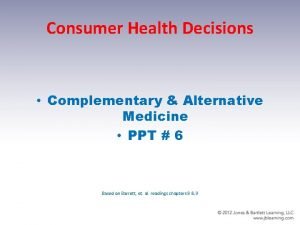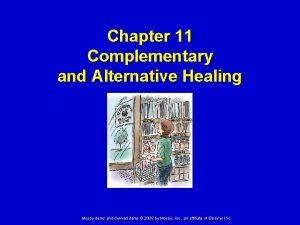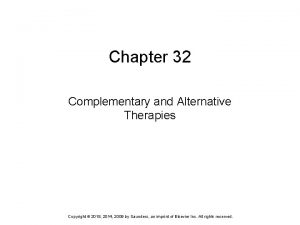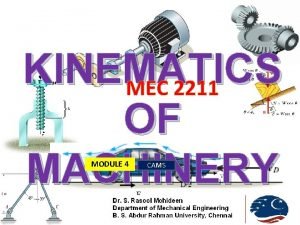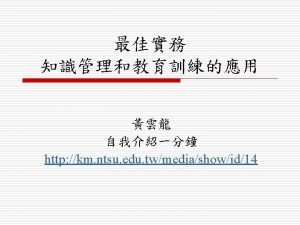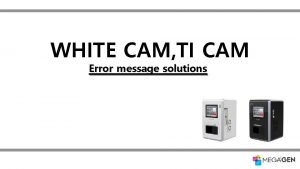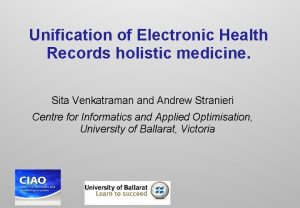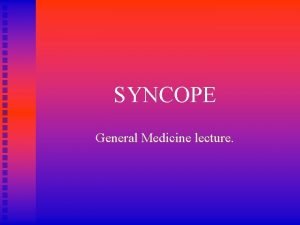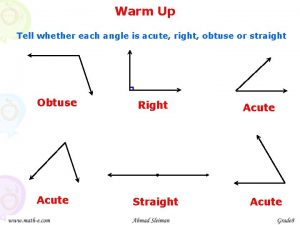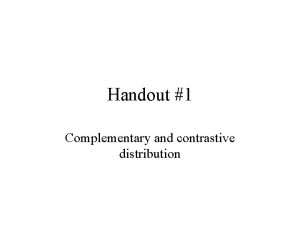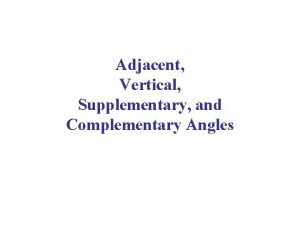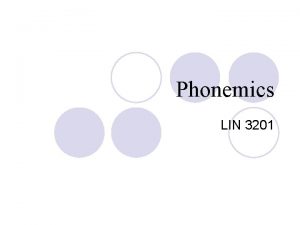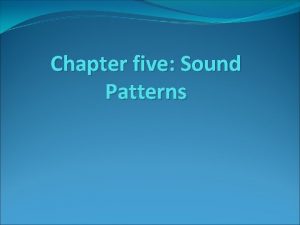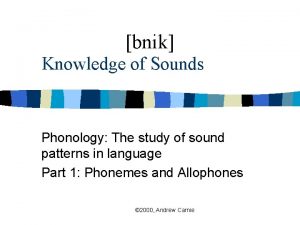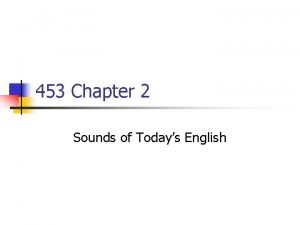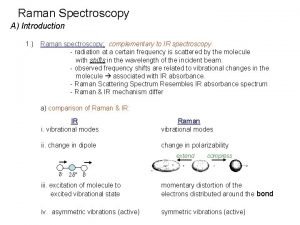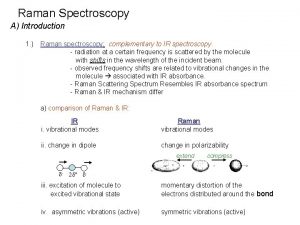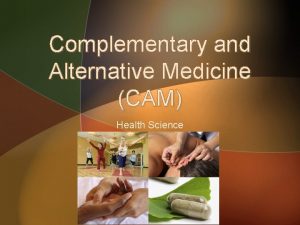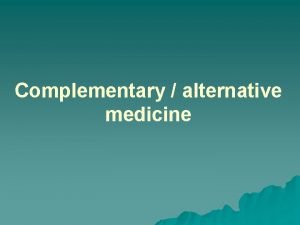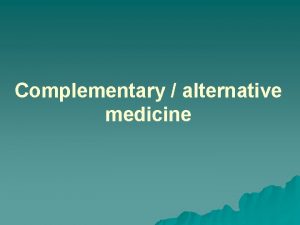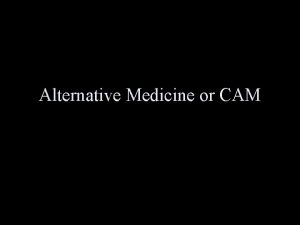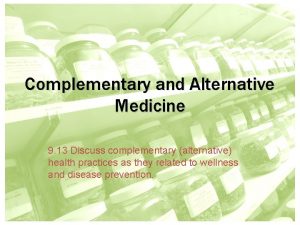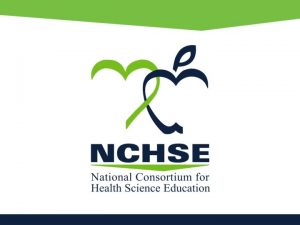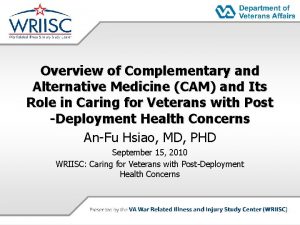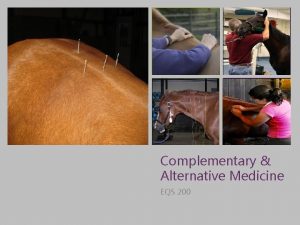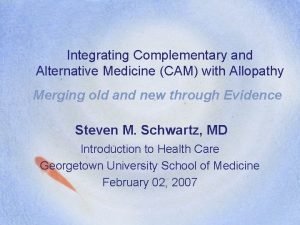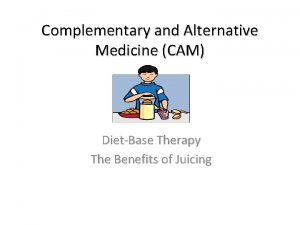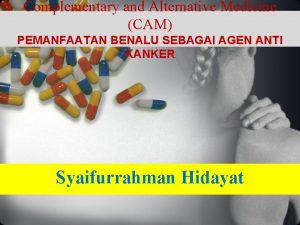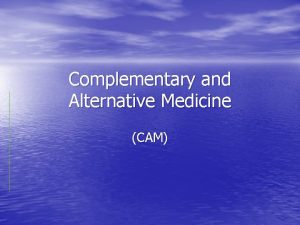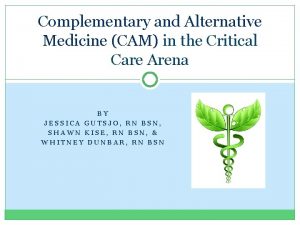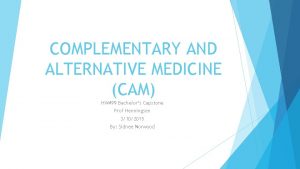4 th lecture Complementary and alternative medicine CAM




















- Slides: 20

4 th lecture: Complementary and alternative medicine (CAM) refers to: a group of medical and health-care systems, practices & products that are not considered to be part of conventional medicine;

Complementary & alternative medicine (CAM) Gingobilobia

Protocol Of The Lectures Epidemiology The Uses Of CAM Definitions of CAM Type Of CAM Recent Advance, Evidence Popularity Safety Big Five Type Of CAM Details Of Some Type CAM

Epidemiology Some forms of CAM are embedded in the cultural norms of particular social and ethnic groups, e. g. traditional Chinese medicine In Western society, the use of CAM is extensive. For example, in 2007 in the USA, 38% of the adult population had used some form of CAM in the previous year (males 33. 5%, females 42. 8%); 12% of children had also used CAM.

most common medical conditions need CAM, were involved : back pain, neck pain, , joint pain/arthritis q Anxiety q raised cholesterol, head or chest ‘colds’ q Headache q insomnia q stress and depression q gastrointestinal symptoms q

CAM covers an enormous and ever-changing range of activities, from well established physical therapies such as osteopathy to spiritual measures such as prayer specifically for health. Proponents suggest that CAM focuses on the whole person: q their lifestyle q environment q diet q mental q Emotional and

definitions ‘Complementary medicine’ is the term used to describe the use of these treatments in conjunction with conventional medicine (e. g. acupuncture to reduce pain after surgery). ‘Alternative medicine’ describes their use in place of conventional medicine (e. g. reflexology instead of anti-inflammatory drugs for arthritis). Clearly, most forms of treatment can be used in either way, so the term CAM is often used generically. ‘Integrative medicine’ describes the use of

The National Center for Complementary and Alternative Medicine in the USA uses the following classification: taxonomies 1) 2) 3) 4) 5) 6) Alternative medical systems. Mind–body interactions. Biologically based therapies Manipulative and body-based methods Energy therapies Some forms of CAM ( embedded) in the cultural norms

Alternative medical systems. These have their own constructs of theory and practice, often based on ancient historical beliefs. Examples are : Ø homeopathy, ( coffee for insomnia) Ø naturopathy, ( body healing power) Ø traditional Chinese medicine and Ø Ayurveda. (harmony and balance )

Mind–body interactions: These rely on the mind’s capacity to influence physical function. Examples are: Ø meditation, ( person attention ) Ø biofeedback, ( consciously regulate body function ) Ø prayer for healing Ø mental healing Ø music therapy and

mind–body medicine Some evidence supports the role of such practices in the treatment of: o asthma, o coronary artery disease o Cancer o osteoarthritic pain o low back pain o chronic headache o smoking cessation

Other type • Biologically based therapies: These involve the use or regulation of an extraneous agent or preparation include: Ø herbal medicine Ø dietary supplementation Ø nutritional medicine • Manipulative and body-based methods: These are based on manipulation or movement of parts of the body. They include: Ø osteopathy Ø chiropractic, ( mapulation, adjesment ) Ø reflexology (rub ), and

Other Therapy • Energy therapies: These involve use of energy fields. Examples include : Ø qigong, (gentle physical movement) in ancient chines Ø Reiki: ( life force energy from therapist to patient ) Reduce: stress, pain, and fatigue Ø therapeutic touch ( finger tip) Ø Some forms of CAM: are embedded in the cultural norms of particular social and ethnic groups, e. g. : traditional Chinese medicine.

Herbal therapy defined as: products other than vitamins and minerals taken by mouth and containing dietary ingredients intended to supplement the diet. E. g. Glucosamine chondroitin for Osteoarthritis St. John's wort for Depression Ginkgo biloba for Dementia Phyto-estrogens for Menopausal symptoms Saw palmetto for Benign prostatic hyperplasia Echinacea for Upper respiratory tract infection

Safety of CAM Not all CAM therapies are safe; i. ii. Some are toxic in their own right (e. g. dietary supplements containing ephedrine alkaloids, now banned in USA) Others are harmful if used in combination with conventional treatment (e. g. garlic supplements that interfere with the action of anti-HIV chemotherapy) iii. Others have been associated with rare but serious sideeffects, which can be life-threatening (e. g. bowel perforation from coffee enemas, hyponatraemia from noni juice).

potential for harm Potential for harm when CAM is used to treat serious or life -threatening medical conditions, if the resultant delay in seeking conventional treatment compromises clinical outcome. On balance, however, the relative safety of most CAM therapies can be regarded as a positive feature; homeopathy is an example.

The popularity of CAM may reflect the: lack of confidence in conventional medicine, particularly a belief that it will not help the condition or may cause harm often used by cancer patients who have disease which is unresponsive to conventional medicines. increasing ease of access to information &therapies via the Internet. CAM is often seeming to be completely safe; patients may therefore be willing to experiment with it as a ‘no-lose’ measure. inherently pleasurable, Many forms of CAM regardless of any therapeutic benefit

Quiz Q: enumerate the types of environmental hazard for the health.

Quiz Q: define the biological hazard, give an example for each type

 Alternative therapy ppt
Alternative therapy ppt Chapter 11 complementary and alternative medicine
Chapter 11 complementary and alternative medicine Chapter 32 complementary and alternative therapies
Chapter 32 complementary and alternative therapies Radial follower
Radial follower Ntsu eeclass
Ntsu eeclass External estop requested
External estop requested Webcam chat 1 on 1
Webcam chat 1 on 1 Alternative medicine ehr
Alternative medicine ehr 01:640:244 lecture notes - lecture 15: plat, idah, farad
01:640:244 lecture notes - lecture 15: plat, idah, farad General medicine lecture
General medicine lecture Classify each angle as acute obtuse right or straight
Classify each angle as acute obtuse right or straight Complementary and supplementary angles formula
Complementary and supplementary angles formula Contrastive distribution linguistics
Contrastive distribution linguistics Complementary and supplementary angles definition
Complementary and supplementary angles definition Adj angle supp
Adj angle supp Free variation and complementary distribution
Free variation and complementary distribution Distinctive feature theory in phonology
Distinctive feature theory in phonology Complementary distribution examples
Complementary distribution examples Free variation and complementary distribution
Free variation and complementary distribution What is the difference between ftir and raman spectroscopy
What is the difference between ftir and raman spectroscopy Why are raman and ir complementary
Why are raman and ir complementary
